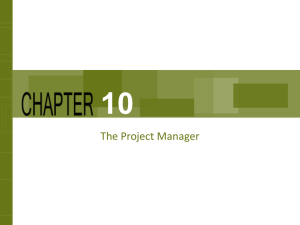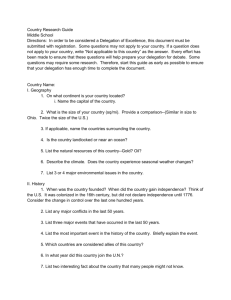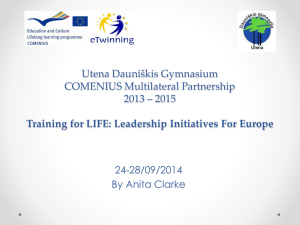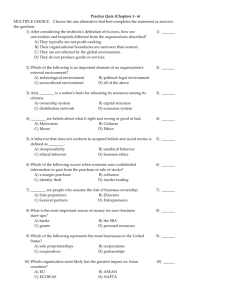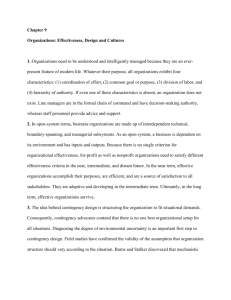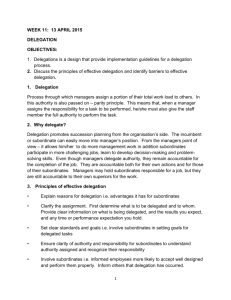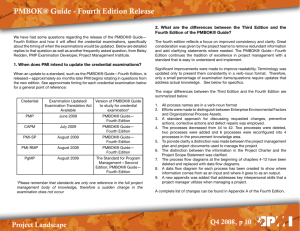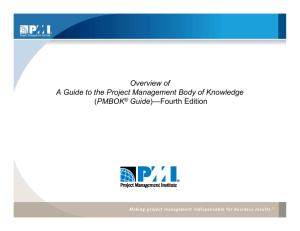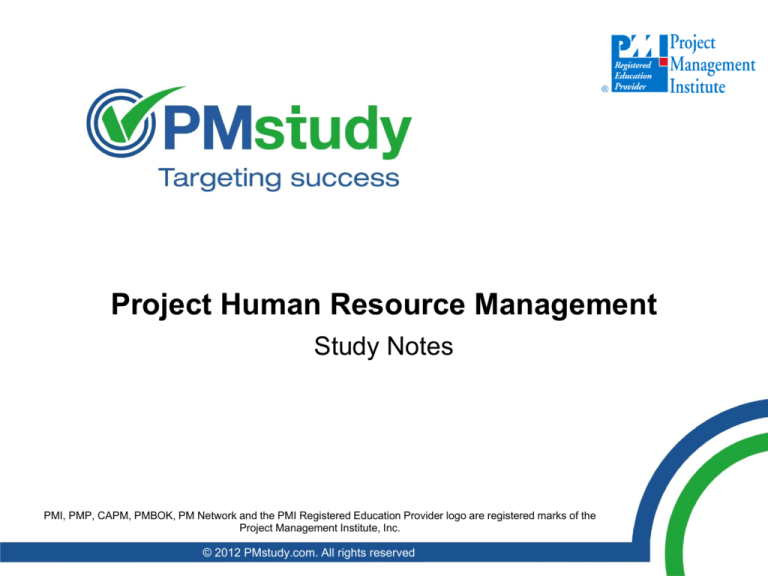
Project Human Resource Management
Study Notes
PMI, PMP, CAPM, PMBOK, PM Network and the PMI Registered Education Provider logo are registered marks of the
Project Management Institute, Inc.
© 2012 PMstudy.com. All rights reserved
Points to Note
• Please read Chapter 9 from Project Management Institute, A Guide to the Project
Management Body of Knowledge, (PMBOK® Guide) – Fourth Edition, Project Management
Institute, Inc., 2008 (pages 215-242).
• The study notes explain topics that are important for PMP® exam preparation, and you can
expect several questions from these topics.
• It is very important to understand all the concepts discussed in this chapter, so please pay
close attention to all the terms used.
• Try to relate the concepts to real life examples.
• After reading the study notes, please answer the chapter test questions in this knowledge
area. The chapter questions improve your understanding of the concepts discussed in the
study notes.
© 2012 PMstudy.com. All rights reserved
2
What is Project Human Resource
Management?
• Processes that help project managers and other managers to organize, and manage all the
project stakeholders’ expectations.
• Processes that explain how to make the most effective use of the people involved with the
project, including all stakeholders.
• Major Human Resource Management processes are:
◦ Develop Human Resource Plan
◦ Acquire Project Team
◦ Develop Project Team
◦ Manage Project Team
Please refer to figure 9-1, on page 217, in PMBOK® Guide Fourth Edition, which provides an
overview of the processes in Project Human Resource Management.
© 2012 PMstudy.com. All rights reserved
3
Develop Human Resource Plan
• Identifies and documents roles, responsibilities, required skills, and reporting relationships and
creates staffing management plan. The roles can be assigned to persons or to groups, who
could be part of the organization performing the project or external to it.
• Identifies the training needs, strategies for team building, programs to recognize and reward,
and issues regarding safety and compliance.
• Is planned in the early stages in most projects.
• Is closely linked with Communications Planning, since the performing organization’s structure
has a major influence on the project’s human resource requirements.
© 2012 PMstudy.com. All rights reserved
4
Human Resource Plan
• Output of Develop Human Resource Plan
• Part of the Project Management Plan
• Provides guidance on how we should define, staff, manage, control, and finally release project
human resources
• Should definitely include:
◦ Role and responsibility assignments:
• Project roles and responsibilities are closely linked to the Define Scope process.
• Roles (who does what), authority (who decides what), responsibility (work expected to be
performed), and competency (skill and capacity needed to complete the activities in the
project) are defined, and role clarity is documented for the project’s human resources.
© 2012 PMstudy.com. All rights reserved
5
Human Resource Plan (continued)
Staffing management plan:
• Describes when and how human resource requirements are met
• Can be formal/informal, highly detailed/broadly framed depending on the needs of the project
• Contains information on staff acquisition, resource calendars, staff release plan, training
needs, recognition and rewards, compliance, and safety
Project organization chart:
• Is a graphical display of project team members and their reporting relationships
• Can be formal/informal, highly detailed/broadly framed depending on the need of the project
For details, please refer to PMBOK® Guide Fourth Edition, page 222-223.
© 2012 PMstudy.com. All rights reserved
6
Acquire Project Team
• In this process, human resource availability is confirmed, and the team necessary to complete
the project is acquired.
• Points the project manager/project management team has to consider while acquiring the
project team:
◦ Effectively negotiate and influence those who can provide required human resources
◦ Failure to acquire the required human resources could affect the success of the project and
could even result in project cancellation
◦ Alternative resources, even if less competent, should be assigned if, for any reason, the
required human resources are not available. By so doing, no regulatory/legal/mandatory, or
any other criteria should be violated
• The tools and techniques used for this process are:
◦ Pre-assignment
◦ Negotiation
◦ Acquisition
◦ Virtual teams
© 2012 PMstudy.com. All rights reserved
7
Acquire Project Team (continued)
•
The outputs for the Acquire Project Team process are:
◦
Project Staff Assignments: The project staff members are assigned, and the assignments
are documented
◦
Resource Calendars: They document the time periods each member works on the project
◦
Project Management Plan Updates: The project management plan should be updated with
human resource plan after completion of the above two sub-processes
© 2012 PMstudy.com. All rights reserved
8
Develop Project Team
• Process that improves the competencies, interactions among the team members, and the
overall team environment to enhance project performance
• Objectives of developing a project team include:
◦ Enhance the skills and knowledge of team members
◦ Enhance a feeling of trust and agreement among team members
◦ Enhance cohesiveness among team members to improve both individual and team
productivity
© 2012 PMstudy.com. All rights reserved
9
Tools And Techniques For Develop
Project Team
• Interpersonal Skills
• Training
• Team Building Activities
• Ground Rules
• Co-location
• Recognition and Rewards
◦For more details, please refer to PMBOK® Guide Fourth Edition, pages 232-234.
© 2012 PMstudy.com. All rights reserved
10
Manage Project Team
• Process to track team member performance, provide feedback, resolve issues, and manage
changes to optimize project performance.
• Project team management achieves the following objectives:
◦ Change results are submitted
◦ Human resource plan is updated
◦ Issues are resolved
◦ Inputs for performance appraisals are provided
◦ Lessons learned document is added to the organization’s database
• The project management team should:
◦ Observe team behavior
◦ Manage conflict
◦ Resolve issues
◦ Appraise team members’ performance
© 2012 PMstudy.com. All rights reserved
11
Tools and Techniques for Manage
Project Team
• Observation and Conversation
• Project performance Appraisals
• Conflict Management
• Issue Log
• Interpersonal skills
For more details, please refer to PMBOK® Guide Fourth Edition, pages 238-241
© 2012 PMstudy.com. All rights reserved
12
Maslow’s Hierarchy of Needs
Source: Project Management - A Systems Approach To Planning, Scheduling, And Controlling (pages
195-196)
© 2012 PMstudy.com. All rights reserved
13
Herzberg's Theory of Motivators and
Hygiene Factors
• Factors such as company policy, supervision, interpersonal relations, working conditions, and
salary are the hygiene factors. The absence of the hygiene factors can create job
dissatisfaction, but their presence does not guarantee motivation or satisfaction.
• Achievement, recognition, the work itself, responsibility, and advancement are motivators
(satisfiers). They are associated with long-term positive effects in job performance. The
hygiene factors (dissatisfiers) consistently produce only short-term changes in job attitudes
and performance.
• The satisfiers relate to what a person does, while the dissatisfiers relate to the situation in
which the person does what he or she does.
© 2012 PMstudy.com. All rights reserved
14
Handling Conflicts
• Blake and Mouton have delineated five modes for handling conflicts:
◦ Withdrawal: Retreat or withdraw from a potential disagreement
◦ Smoothing: De-emphasize or avoid areas of differences and emphasize areas of
agreement
◦ Compromising: Bargain and search for solutions that bring some degree of satisfaction to
the parties in a dispute
◦ Forcing: Exert one’s viewpoint at the potential expense of another—characterized by
competitiveness and a win-lose situation
◦ Confrontation: Handling the conflict directly, which involves a problem solving approach
whereby affected parties work through their disagreements.
Source: Project Management - A Systems Approach to Planning, Scheduling, and Controlling,
pages 304, 305, and 306
© 2012 PMstudy.com. All rights reserved
15
Conflict Intensity
• Most of the conflicts occur due to the following issues (in order of decreasing intensity)
Highest Intensity
•
Schedules
•
Priorities
•
Manpower
•
Technical
•
Procedures
•
Personality
•
Costs
Lowest Intensity
Source: Project Management - A Systems Approach to Planning, Scheduling, and Controlling,
page 302
© 2012 PMstudy.com. All rights reserved
16
Management/Leadership Styles
• Some common management/leadership styles are:
◦
Autocratic: Manager makes decisions himself or herself- allows subordinates little involvement and
discussion before a decision is made
◦
Laissez faire: Manager does not interfere with subordinates – so subordinates are largely unsupervised,
which may lead to anarchy
◦
Democratic: Manager allows subordinates to discuss issues and reach decisions, although he or she will
guide and advise
◦
Discussing: There is two-way communication and discussion between manager and subordinates
◦
Directing: Managers tell people what tasks will be performed and when and how they should be done
◦
Delegating: Manager delegates to get consensus on what has been achieved and what needs to be done
◦
Coaching: Manager issues instructions to others
◦
Facilitating: Manager coordinates inputs from several sources before making a decision
◦
Participatory
◦
Supportive
◦
Task oriented
◦
Team-based
◦
Assertive
© 2012 PMstudy.com. All rights reserved
17
Types of Roles People Play in a Project
• Destructive Roles
• Supportive Roles
◦ Aggressor
◦
Information Seekers
◦ Dominator
◦
Information Givers
◦ Devil’s Advocate
◦
Encouragers
◦ Topic Jumper
◦
Clarifiers
◦ Recognition Seeker
◦
Harmonizers
◦ Withdrawer
◦
Consensus Takers
◦ Blocker
◦
Gate Keepers
◦
Initiators
Reference: A Systems Approach to Planning, Scheduling, and Controlling (pages 181-182)
© 2012 PMstudy.com. All rights reserved
18
Delegation
• A method and style of management by which the project manager distributes responsibility for
proper performance of a task to a team member working on the project.
• Project manager, even after delegating responsibility to a team member, still retains the
ultimate responsibility for the end results.
• Project manager also agree to be held accountable for the decision to delegate.
• Involves:
◦
◦
◦
◦
◦
Giving responsibility (obligation to perform the assigned tasks)
Gaining acceptance (the team member's agreement to be responsible)
Granting authority (the right and power to accomplish the tasks)
Expecting reliability (assurance of best and consistent effort)
Requiring accountability (accepting responsibility for success or failure).
Please note: The concept and process of delegation can be illustrated by the "4D's" model
(Drop, Delay, Delegate, and Do).
© 2012 PMstudy.com. All rights reserved
19
Delegation (continued…)
• Project managers should delegate:
◦ Routine tasks
◦ Tasks that require technical expertise
◦ What someone else can do better
◦ Projects involving the critical, visible issues of quality, quantity, cost, and timeliness to selfmanaged project teams or self-directed teams.
• Project managers should not fully delegate:
◦ Long range planning (although they should involve others)
◦ Selection, monitoring, motivation, evaluation (performance appraisal) and rewarding of key team
players
◦ Personal matters
• Practical method for effective delegation:
◦ There are eight essential ingredients of effective delegation, which can be represented by the
acronym: 2 x ETFP, which stands for Easy To Follow Procedures. Effective and successful
delegation involves four steps, each having two major ingredients.
• E ⇒ Entrust and Enlist
• T ⇒ Teach and Touch
• F ⇒ Familiarize and Follow up
• P ⇒ Praise (the Process) and Participate (in Feedback)
© 2012 PMstudy.com. All rights reserved
20
Delegation (continued…)
• The project manager must assign responsibility, grant appropriate authority, expect reliability,
and require accountability from the delegatees.
• Authority confers the right to impose some degree of obedience.
• Responsibility confers the obligation on the delegatee to act with or without detailed guidance
or specific authorization.
• Reliability encompasses two main factors—track record and quality of work.
• Accountability in the project context is the extent to which individuals are answerable and must
provide visible evidence of their actions.
Reference: Organizing Projects for Success (Human Aspects of Project Management) by Vijay
Verma. Chapter 4: Important Issues in Project Organizational Design
© 2012 PMstudy.com. All rights reserved
21
Delegation (continued…)
© 2012 PMstudy.com. All rights reserved
22


